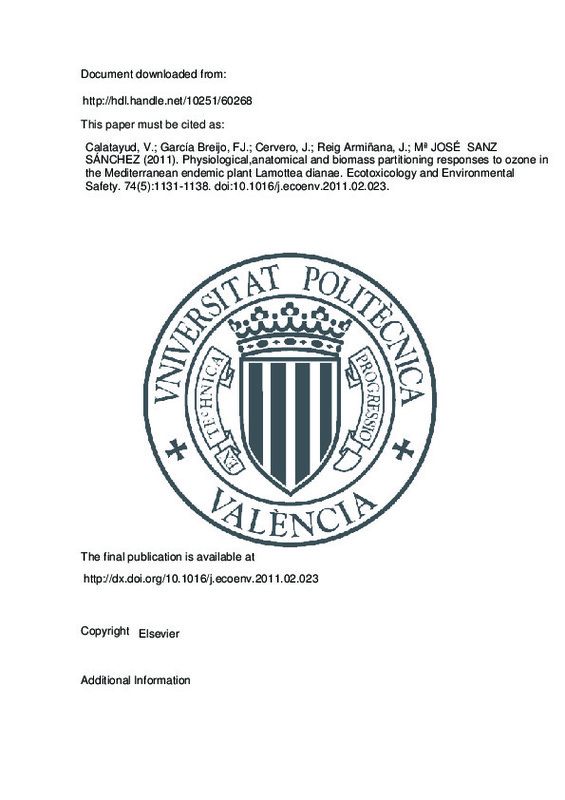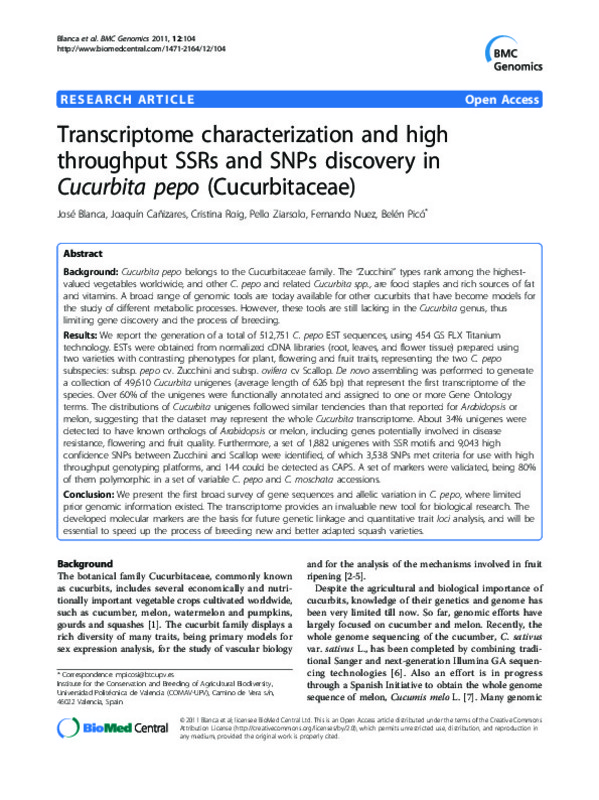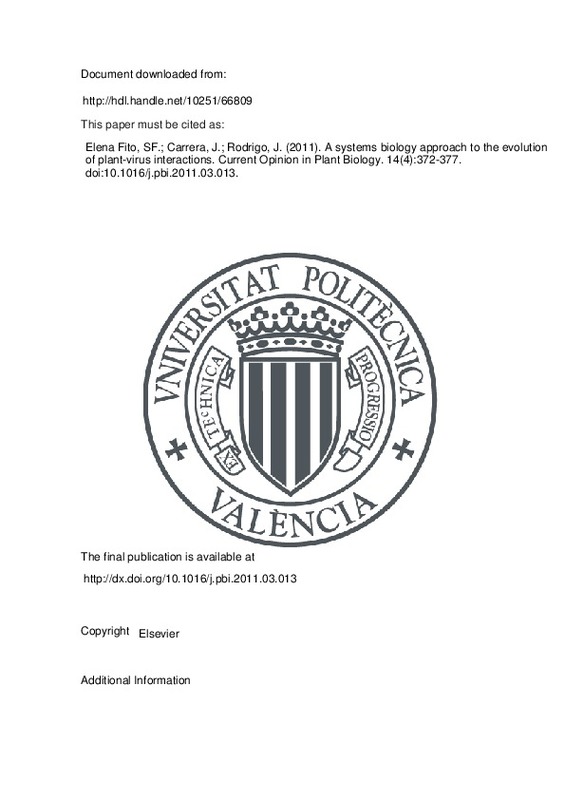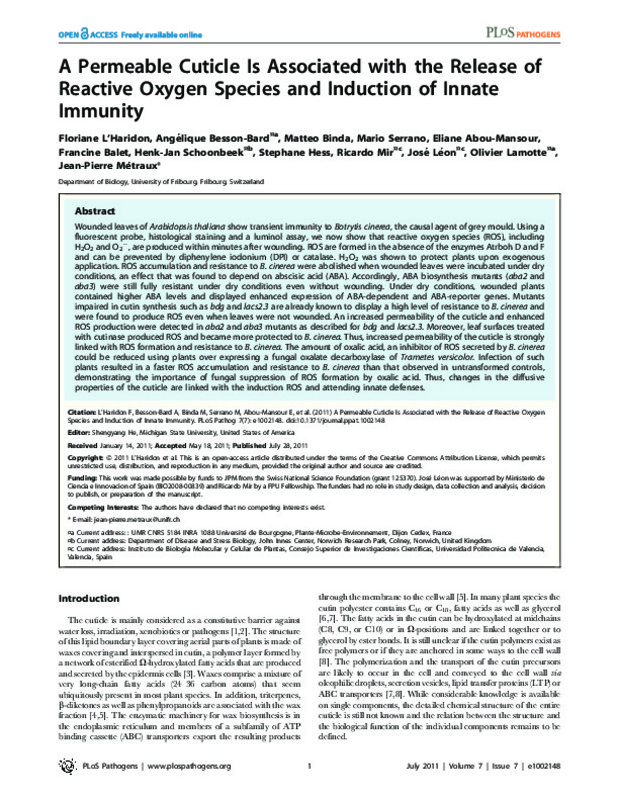Calatayud, V.; García Breijo, FJ.; Cervero, J.; Reig Armiñana, J.; Sanz Sánchez, MJ. (2011). Physiological,anatomical and biomass partitioning responses to ozone in the Mediterranean endemic plant Lamottea dianae. Ecotoxicology and Environmental Safety. 74(5):1131-1138. doi:10.1016/j.ecoenv.2011.02.023
Por favor, use este identificador para citar o enlazar este ítem: http://hdl.handle.net/10251/60268
|
Título:
|
Physiological,anatomical and biomass partitioning responses to ozone in the Mediterranean endemic plant Lamottea dianae
|
|
Autor:
|
Calatayud, V.
García Breijo, Francisco José
Cervero, J
Reig Armiñana, José
Sanz Sánchez, Maria Jose
|
|
Entidad UPV:
|
Universitat Politècnica de València. Departamento de Ecosistemas Agroforestales - Departament d'Ecosistemes Agroforestals
|
|
Fecha difusión:
|
|
|
Resumen:
|
Ozone effects on the perennial forb Lamottea dianae were studied in an open-top chamber experiment. Ozone was found to induce reductions in CO 2 assimilation and water use efficiency in the leaves of this species. These ...[+]
Ozone effects on the perennial forb Lamottea dianae were studied in an open-top chamber experiment. Ozone was found to induce reductions in CO 2 assimilation and water use efficiency in the leaves of this species. These reductions were mainly related to a decline in the in vivo CO 2 fixation capacity of Rubisco (V c,max), rather than to stomatal limitations or photoinhibitory damage (F v:F m). In addition to chloroplast degeneration, other observed effects were callose accumulation, formation of pectinaceous wart-like cell wall exudates and phloem alterations. Moreover, ozone exposure significantly reduced root dry biomass. The possible relevance of these adverse effects for Mediterranean forbs is commented. These results show that endemic plants can be very sensitive to ozone, suggesting that risks associated with this pollutant should be taken into account for conservation purposes. © 2011 Elsevier Inc.
[-]
|
|
Palabras clave:
|
Anatomy
,
Biomass partitioning
,
Endemic plants
,
Oxidative stress
,
Ozone
,
Photosynthesis
,
Rubisco
,
Biomass allocation
,
Carbon dioxide
,
Endemic species
,
Environmental stress
,
Physiological response
,
Plant
,
Species conservation
,
Water use efficiency
,
Adverse outcome
,
Anatomical variation
,
Article
,
Carbon dioxide fixation
,
Controlled study
,
Degeneration
,
Environmental impact
,
Environmental protection
,
In vivo study
,
Lamottea dianae
,
Nonhuman
,
Phloem
,
Photoinhibition
,
Physiological process
,
Plant damage
,
Plant exudate
,
Plant water use
,
Pollen
,
Risk factor
,
Southern Europe
,
Stomatal conductance
,
Asteraceae
,
Biomass
,
Chlorophyll
,
Chloroplasts
,
Plant Leaves
,
Plant Roots
,
Spain
|
|
Derechos de uso:
|
Reserva de todos los derechos
|
|
Fuente:
|
Ecotoxicology and Environmental Safety. (issn:
0147-6513
)
|
|
DOI:
|
10.1016/j.ecoenv.2011.02.023
|
|
Editorial:
|
Elsevier
|
|
Versión del editor:
|
http://dx.doi.org/10.1016/j.ecoenv.2011.02.023
|
|
Agradecimientos:
|
We thank the Conselleria de Medi Ambient, Aigua, territory i Habitatge and FEDER funds (project VegetPollOzone, Interreg IIIb, Meddoc) for supporting parts of this study. The Instituto Universitario CEAM-UMH is partly ...[+]
We thank the Conselleria de Medi Ambient, Aigua, territory i Habitatge and FEDER funds (project VegetPollOzone, Interreg IIIb, Meddoc) for supporting parts of this study. The Instituto Universitario CEAM-UMH is partly supported by Generalitat Valenciana, Fundacion Bancaja, and benefits form the projects CONSOLIDER-INGENIO 2010 (GRACCIE) and Prometeo Program (Generalitat Valenciana). Emilio Laguna and Mari Carmen Escriva are also thanked for providing us the plants and, together with Joan Perez, for their comments on aspects of the biology of this species. Carmen Martin is thanked for taking care of the plants. Four anonymous referees provided very useful comments for improving the manuscript.
[-]
|
|
Tipo:
|
Artículo
|







![[Cerrado]](/themes/UPV/images/candado.png)




